小学三年级fruit课件
- 格式:ppt
- 大小:2.13 MB
- 文档页数:14
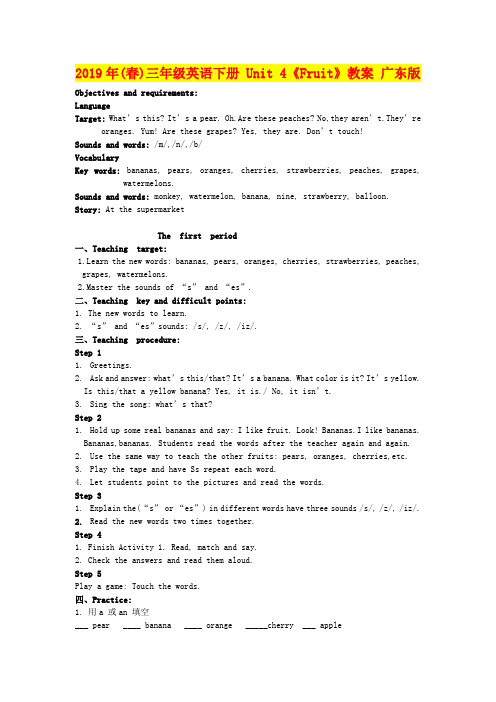
2019年(春)三年级英语下册 Unit 4《Fruit》教案广东版Objectives and requirements:LanguageTarget:What’s this? It’s a pear. Oh.Are these peaches? No,they aren’t.They’re oranges. Yum! Are these grapes? Yes, they are. Don’t touch!Sounds and words: /m/,/n/,/b/VocabularyKey words: bananas, pears, oranges, cherries, strawberries, peaches, grapes, watermelons.Sounds and words: monkey, watermelon, banana, nine, strawberry, balloon.Story: At the supermarketThe first period一、Teaching target:1.Learn the new words:bananas, pears, oranges, cherries, strawberries, peaches, grapes, watermelons.2.Master the sounds of “s” and “es”.二、Teaching key and difficult points:1. The new words to learn.2. “s” and “es”sounds: /s/, /z/, /iz/.三、Teaching procedure:Step 11.Greetings.2.Ask and answer: what’s this/that? It’s a banana. What color is it? It’s yellow. Is this/that a yellow banana? Yes, it is./ No, it isn’t.3.Sing the song: what’s that?Step 21.Hold up some real bananas and say: I like fruit. Look! Bananas.I like bananas. Bananas,bananas. Students read the words after the teacher again and again.e the same way to teach the other fruits: pears, oranges, cherries,etc.3.Play the tape and have Ss repeat each word.4.Let students point to the pictures and read the words.Step 31.Explain the(“s”or “es”) in different words have three sounds /s/, /z/, /iz/.2.Read the new words two times together.Step 41. Finish Activity 1. Read, match and say.2. Check the answers and read them aloud.Step 5Play a game: Touch the words.四、Practice:1. 用a 或an 填空___ pear ____ banana ____ orange _____cherry ___ apple____ grape _____ peach _____ watermelon _____ strawberry五、Homework:1.Copy the new words for eight times.2. Read the new words for three times.六、Write on the blackboard:Unit 4 Fruit单数 a banana a pear an orange a cherry复数 banana s pear s orange s cherr ies单数 a strawberry a peach a grape a watermelon复数 strawberr ies peach es grape s watermelon sThe second period一、Teaching target:1.Can read and use the new words to practice.2.掌握名词的单数与复数的形式变化。
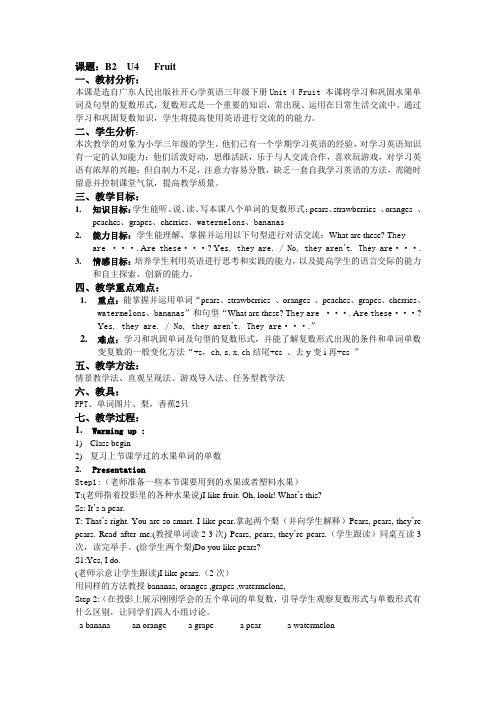
课题:B2 U4 Fruit一、教材分析:本课是选自广东人民出版社开心学英语三年级下册Unit 4 Fruit 本课将学习和巩固水果单词及句型的复数形式,复数形式是一个重要的知识,常出现、运用在日常生活交流中。
通过学习和巩固复数知识,学生将提高使用英语进行交流的的能力。
二、学生分析:本次教学的对象为小学三年级的学生,他们已有一个学期学习英语的经验,对学习英语知识有一定的认知能力;他们活泼好动,思维活跃,乐于与人交流合作,喜欢玩游戏,对学习英语有浓厚的兴趣;但自制力不足,注意力容易分散,缺乏一套自我学习英语的方法,需随时留意并控制课堂气氛,提高教学质量。
三、教学目标:1.知识目标:学生能听、说、读、写本课八个单词的复数形式:pears、strawberries 、oranges 、peaches、grapes、cherries、watermelons、bananas2.能力目标:学生能理解、掌握并运用以下句型进行对话交流:What are these? T heyare ···. A re these···? Y es, they are. / No, they aren’t. They are···.3.情感目标:培养学生利用英语进行思考和实践的能力,以及提高学生的语言交际的能力和自主探索、创新的能力。
四、教学重点难点:1.重点:能掌握并运用单词“pears、strawberries 、oranges 、peaches、grapes、cherries、watermelons、bananas”和句型“What are these? T hey are ···. A re these···?Y es, they are. / No, they aren’t. They are···.”2.难点:学习和巩固单词及句型的复数形式,并能了解复数形式出现的条件和单词单数变复数的一般变化方法“+s,ch,s,x,ch结尾+es 、去y变i再+es ”五、教学方法:情景教学法、直观呈现法、游戏导入法、任务型教学法六、教具:PPT、单词图片、梨,香蕉2只七、教学过程:1.Warming up :1)Class begin2)复习上节课学过的水果单词的单数2.PresentationStep1:(老师准备一些本节课要用到的水果或者塑料水果)T:(老师指着投影里的各种水果说)I like fruit. Oh, look! What’s this?Ss: It’s a pear.T: That’s right. You are so smart. I like pear.拿起两个梨(并向学生解释)Pears, pears, they’re pears. Read after me.(教授单词读2-3次) Pears, pears, they’re pears.(学生跟读)同桌互读3次,读完举手。
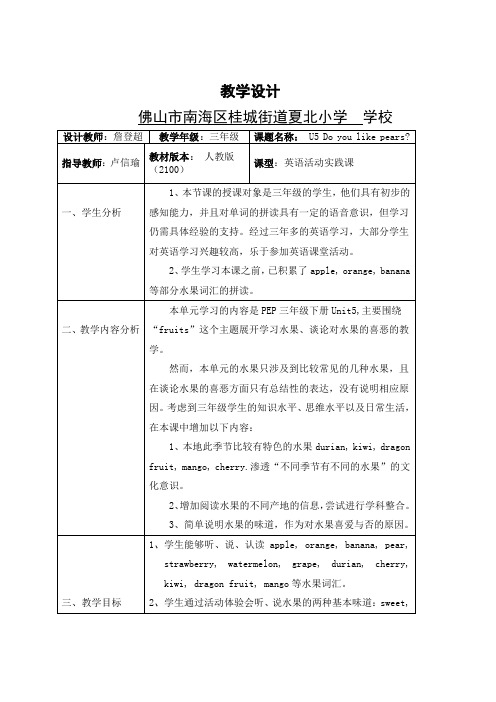
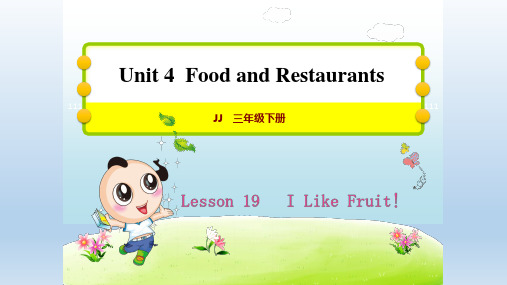

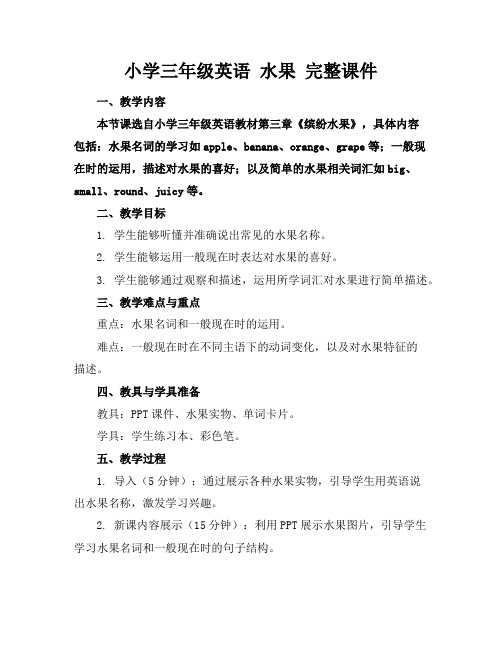
小学三年级英语水果完整课件一、教学内容本节课选自小学三年级英语教材第三章《缤纷水果》,具体内容包括:水果名词的学习如apple、banana、orange、grape等;一般现在时的运用,描述对水果的喜好;以及简单的水果相关词汇如big、small、round、juicy等。
二、教学目标1. 学生能够听懂并准确说出常见的水果名称。
2. 学生能够运用一般现在时表达对水果的喜好。
3. 学生能够通过观察和描述,运用所学词汇对水果进行简单描述。
三、教学难点与重点重点:水果名词和一般现在时的运用。
难点:一般现在时在不同主语下的动词变化,以及对水果特征的描述。
四、教具与学具准备教具:PPT课件、水果实物、单词卡片。
学具:学生练习本、彩色笔。
五、教学过程1. 导入(5分钟):通过展示各种水果实物,引导学生用英语说出水果名称,激发学习兴趣。
2. 新课内容展示(15分钟):利用PPT展示水果图片,引导学生学习水果名词和一般现在时的句子结构。
3. 例题讲解(10分钟):讲解一般现在时在不同主语下的动词变化,并以水果为例进行示范。
4. 随堂练习(15分钟):学生根据PPT上展示的水果图片,用一般现在时描述水果的特征。
5. 小组活动(10分钟):学生分组,每组选择一种水果,用英语进行描述,并展示给其他小组。
六、板书设计1. 水果名词:apple、banana、orange、grape等。
2. 一般现在时的句子结构:主语 + 动词原形/第三人称单数形式。
3. 水果特征描述词汇:big、small、round、juicy等。
七、作业设计1. 作业题目:用英语描述你喜欢的水果,并说明原因。
答案:例:I like apples. They are sweet and juicy.(我喜欢苹果,因为它们又甜又多汁。
)八、课后反思及拓展延伸本节课通过实物展示、PPT课件和小组活动等多种形式,让学生在轻松愉快的氛围中学习水果名词和一般现在时的运用。
小学英语fruit水果优质课件一、教学内容本节课选自小学英语教材第三章《食物与购物》的第二节《美味水果》,详细内容围绕生活中常见的水果,如apple、banana、orange等进行词汇学习和简单句子构造。
二、教学目标1. 让学生掌握基本的常见水果英文单词。
2. 学会使用简单的句子描述喜欢的水果。
3. 培养学生运用英语进行简单交流的能力。
三、教学难点与重点重点:常见水果的英文单词和简单句子构造。
难点:正确发音和使用句子进行简单交流。
四、教具与学具准备1. 教具:PPT课件、实物水果、单词卡片。
2. 学具:笔记本、彩色笔。
五、教学过程1. 实践情景引入(5分钟)利用PPT展示水果店场景,引导学生用英语描述喜欢的水果。
2. 词汇学习(10分钟)通过展示实物水果和单词卡片,教授学生相关水果的英文单词,如apple、banana、orange等。
3. 句子构造(10分钟)利用PPT上的例句,教授学生如何使用简单句子描述喜欢的水果,如:“I like apples. They are sweet and delicious.”4. 例题讲解(10分钟)选取几个典型例题,讲解句子构造和单词用法。
5. 随堂练习(10分钟)分组进行角色扮演,模拟在水果店购买水果的场景,用英语进行交流。
对本节课所学内容进行回顾,强调重点和难点。
七、作业设计1. 作业题目:请用英语写出你喜欢的水果及原因。
答案示例:I like oranges. They are sweet and rich in vitamin C.2. 作业题目:结合本节课所学,与家长进行一次简单的英语对话,介绍你喜欢的水果。
八、课后反思及拓展延伸1. 反思:关注学生在课堂上的参与度和发音准确性,及时调整教学方法。
2. 拓展延伸:鼓励学生在日常生活中用英语描述所见所闻,提高实际运用能力。
可以开展家庭作业,让学生与家长一起完成,增进亲子互动。
重点和难点解析1. 教学难点与重点的确定。